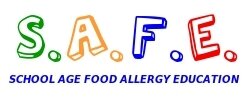- Home
-
Allergy & Asthma Information
- Asthma: The Basics
- Living With Asthma
- Asthma Tools
- Asthma Triggers
- Asthma & Eczema
- Asthma & Allergy
- Hay Fever
- How to use a:
- About Us
- Order Info
Asthma and Anaphylaxis
What Is Anaphylaxis?
- Anaphylaxis is a severe allergic reaction.
- Different parts of the body can be affected all at once.
- The signs of anaphylaxis may not always be the same.
- Anaphylaxis is most often caused by foods, medicines or insect stings. It can be caused by other things, such as latex or exercise.
- Reactions are unpredictable, but usually occur within a few minutes after contact.
- Anaphylaxis almost always occurs within an hour after contact, but can happen up to 2 hours later.
- Antihistamine medicines will not prevent or stop anaphylaxis.
- Anaphylaxis is a medical emergency. Death can occur.
Asthma And Anaphylaxis
- Anaphylactic reactions can be worse if you also have asthma, especially if asthma is not well controlled.
- Trouble breathing can occur with both asthma and anaphylaxis. It usually comes on more quickly with anaphylaxis.
- Adrenalin (epinephrine) is needed to treat anaphylaxis.
- Asthma inhalers will not work for anaphylaxis.
- Some allergies, such as dog, can trigger asthma, but are unlikely to cause anaphylaxis.
Signs of Anaphylaxis
- Severe hives or itching that happen over minutes and affect most of the body
- Sudden swelling of the lips, tongue, throat or face
- Drooling or trouble swallowing
- Sudden breathing problems such as cough, wheeze or feeling short of breath
- Severe repeated vomiting
- Dizziness or fainting.
Managing Anaphylaxis
- See an allergy doctor to confirm allergies.
- Learn how to avoid the things you are allergic to. Make sure to avoid them.
- Always carry your epinephrine auto-injector EpiPen®, TwinjectTM or AllerjectTM - It can save your life.
- Check your auto-injector's expiry date. Replace it when it is expired. Review when and how to use it every month.
- Use your auto-injector at the earliest sign of anaphylaxis. Do not wait for breathing problems.
- If in doubt, use the EpiPen®, AllerjectTM or Twinject™!
- As soon as it is used, call 911 or have someone take you to the nearest Emergency Department.
- Make sure that family, friends and other caregivers know about your allergy and anaphylaxis plan.
- Make sure they know how to use the auto-injector.
- School age children, teens and adults who are at risk for anaphylaxis should wear MedicAlert® bracelet.
Click the following links for more information on how to's:
AllergjectTM information
Helpful links for food allergy information
Allergic Living Magazine www.allergicliving.com
AnaphylaxisCanada www.anaphylaxis.ca
Allergy Support Centre www.allergysupportcentre.ca
Information for Kids/Anaphylaxis Canada www.safe4kids.ca
Asthma/Allergy Information Association www.aaia.ca
Canadian Food Inspection Agency www.inspection.gc.ca
FAAN Food Allergy & Anaphylaxis Network www.foodallergy.org
Resources for Teens with Food Allergies - Click here!
The Children's Allergy & Asthma Education Centre ©2013, 2014
![]()

The Children's Allergy & Asthma Education Centre
Phone: (204) 787-2551
Toll Free: 1-888-554-1141
Fax (204) 787-5040

